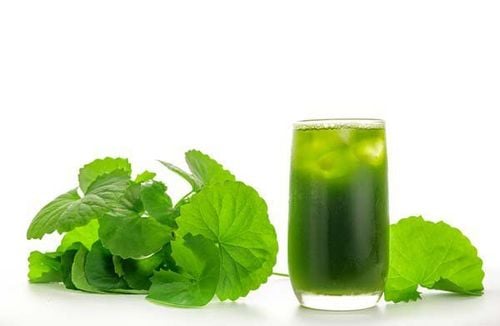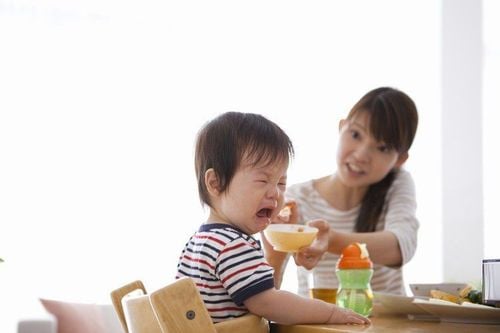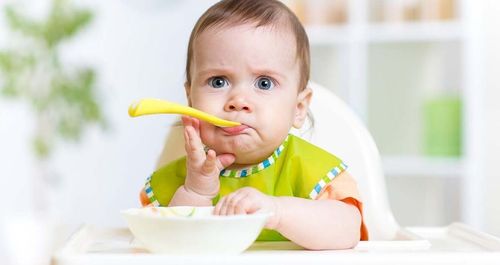This is an automatically translated article.
There are many causes of physiological anorexia in 2-month-old babies. If this condition is prolonged, it can cause malnutrition and decrease resistance. So what are the signs of physiological anorexia in a 2-month-old baby and how to overcome it?
1. What is physiological anorexia in 2-month-old babies?
Two-month-old anorexic children have 3 types:
Psychological anorexia: children are often scared when eating because their parents scold, force them to eat, force them to eat a lot,... Pathological anorexia: usually occurs when children are sick or have diseases such as: digestive disorders, diaper rash, skin diseases, flu, ... Making children tired and lose their appetite. Physiological anorexia: Appears when children enter a new developmental stage such as teething, walking, rolling, sitting,... Different from psychological anorexia and physiological anorexia in 2-month-old babies At age, pathological anorexia will last, if parents do not pay attention and find ways to overcome it. So how long does a 2-month-old child have anorexia physiologically? Normally, children lose their physiological appetite for about 1 to 2 weeks, then they will return to eating and drinking normally.
2. Signs of anorexia in young children
Children with anorexia will have very obvious symptoms. Here are some signs that the baby is in an anorexia state:
For a breastfed baby: The baby naturally sucks less than usual. Sleeps a lot at night and doesn't get up at night to breastfeed. A baby's feeding time is often shorter than usual, refusing to breastfeed. For children who are eating solid foods or eating rice: The child refuses to eat a portion of the meal compared to the child's needs. Usually, each child's meal lasts more than 30 minutes. Children eat less, do not swallow food and hold food in their mouth and spit it out. Children are indifferent to food, cry and fuss every time it comes to meals,... In addition to the above signs, when children are anorexic, daily meals are not their favorite time. Even many parents have a hard time feeding their children. However, parents should not force children to eat too much, or scold children to eat. This is very easy to scare the child and spit up all the food.
3. What is the difference between physiological anorexia and pathological anorexia?
3.1. Physiological anorexia in 2-month-old children Physiological anorexia in children occurs when the child lacks nutrients in the fetus. During pregnancy, if the mother does not have a healthy diet, it will greatly affect the baby. It can lead to premature birth, causing the baby to have anorexia. In addition, when children are transitioning to new developmental stages such as: crawling, rolling, walking, teething, ... also make children eat less. However, the physiological anorexia in children will quickly disappear.
The period of 2 months old anorexic is a condition in which the child suddenly stops eating, is lazy or eats less than usual. By this stage, children are developing strongly physically and mentally. For example:
Children recognize faces: when the baby is 2 months old, he can already recognize the faces of people or around him. When there is a stranger, the baby will cry and may stop eating. Closed posterior fontanel: Mother touching the top of the head can see a soft, this is the baby's back fontanel. When the fontanelle later closes in the child to the 2 month period, it will cause physiological anorexia in the child. Hearing: At the stage of 2 months, the baby's auditory organs gradually mature, requiring more energy. Therefore, children may eat a little more than usual, and then return to eating normally. In this case, many parents may think that the baby is eating less. However, this is not too serious, the child will go away after a while. 3.2. Pathological anorexia Pathological anorexia is usually not caused by poor appetite, but by external factors that also make children anorexic. There are many diseases that cause anorexia in 2-month-old babies, such as:
3.2.1. Children with digestive disorders The digestive system of children after birth is still immature, not yet fully developed, so it is easy to be affected by foreign factors. Symptoms of children with typical digestive disorders such as: abdominal pain, indigestion, vomiting, anorexia, diarrhea,...
3.2.2. Children with thrush Thrush is also known as oral thrush. The main causative agent of the disease is a fungus Candida Albicans. When thrush for children is not done properly, parents can easily make the child's tongue bleed. Sometimes children also have symptoms such as: pain, dry mouth, difficulty in sucking and swallowing milk, etc., which also makes 2-month-old children anorexic.
3.2.3. Diaper rash Diaper rash is very common in babies. Due to the baby's skin being rubbed or this area of the skin is stagnant with urine and feces, the skin is not open, causing the baby to have a diaper rash. This leads to the skin in the baby's buttocks and groin area becoming red, inflamed, and sore.
In addition, when the child has diaper rash, there is also a fever accompanied by diarrhea. All of the above symptoms are causes of anorexia in children.
3.2.4. Skin diseases Skin diseases are common in the summer with hot climates, heat rash on the skin is often seen in 2-month-old babies. When the child has heat rash, on the child's skin will develop blisters and red rashes, making the child very uncomfortable, itchy and fussy, refusing to eat.
When parents see a child with tiny blisters on the skin accompanied by anorexia, parents need to treat the child always to limit the negative effects on the child's health.
3.2.5. Lack of nutrients Vitamins and minerals are essential nutrients for both physical and intellectual development of young children. In addition, they also improve the immune system and increase resistance for children, avoiding diseases. If children are deficient in nutrients, vitamins and minerals, it will cause growth retardation, slow weight gain, or minor illnesses, fussiness, loss of appetite or anorexia, etc. At this time, parents need to supplement nutrients through nutrition. Eat and drink in moderation to increase the quality of milk for nursing babies.
3.2.6. Parasitic infections In 2-month-old infants, parasitic infections are uncommon. Because it will mainly be encountered in older children when children know how to play and play, creating conditions for parasites to develop. The parasites of worms and flukes are very easy to cause abdominal distension and abdominal pain in young children. Therefore, if you see a child crying, skipping meals without finding the cause, it is likely that the child has a parasite infection. At this time, parents should visit the doctor for useful advice for their children.
3.3. Other causes for 2-month-old anorexia In addition to the physiological and pathological causes of 2-month-old anorexia, there are also some other causes as follows:
3.3.1. Psychogenic anorexia The 2-month-old baby has begun to listen to stories and can respond to surrounding sounds. If parents or those around them talk loudly or yell at the baby, it will startle the baby, make the baby cry, feed less or stop feeding. This is what children show on the outside of their fear.
Besides, 2-month-old babies are very sensitive to strange smells. When your breasts secrete a strange smell, it will cause the baby to have anxiety reduction leading to aborting or refusing to suckle.
3.3.2. Side effects of drugs The use of antibiotics also causes intestinal dysbacteriosis in children. Especially when used indiscriminately without a doctor's prescription. Because, when using antibiotics, the drug will destroy both beneficial bacteria and harmful bacteria in the intestinal tract. Children will have bloating, flatulence, constipation, diarrhea, anorexia,...
When the child is 2 months old, it is also the time when children start to receive more vaccines. According to the doctor's recommendations, the side effects of the vaccine make the child anorexia, loss of appetite and the child does not want to receive more breast milk.
3.3.3. Mother's milk is not delicious Mother's diet greatly affects the quality of milk secreted. When the mother is undernourished, the milk loses its delicious taste or worse, has a fishy, bitter taste,... This will make the child anorexic and afraid to eat.
Therefore, to improve the quality of milk, mothers should practice a reasonable and most scientific diet to have an abundant and quality milk supply for the baby. If the milk comes in a lot and the baby doesn't suck it all. You can express milk and store it in the refrigerator.
4. How to overcome physiological anorexia in 2-month-old babies
Parents should not be too worried when they see their 2-month-old anorexic. This period of physiological anorexia will pass quickly and the child will return to eating normally afterwards. Parents can use a number of ways to effectively limit physiological anorexia in 2-month-old babies as follows:
Increase the amount of feeding during the day and reduce the weight of each feeding to shorten the time each meal but still ensure nutrition for children. Supplementing with micronutrients for 2-month-old babies. You can supplement minerals and vitamins through breast milk. If you have supplemented but find that the child is still fussy and anorexic, parents can take the child to a specialist medical facility for specific examination by doctors. Here, the doctor will check to see if the child is deficient in anything and will need to be supplemented properly. Children 2 months old with physiological anorexia can be supplemented with multi-strain probiotics because they have very good digestive disorders. Because probiotics will provide a large amount of beneficial bacteria for the digestive tract. Helps balance intestinal microflora, inhibits the growth of harmful bacteria. This helps to improve bloating, vomiting, diarrhea and anorexia in children very well. Feed the baby properly by feeding the baby on which breast, using the hand on the same side of that breast to support the baby. The first 3 points, the baby's back and bottom are in a straight line, the baby's belly touches the mother's belly, the baby's face touches the mother's chest. In addition, many mothers often breastfeed their babies on their backs with their heads tilted towards the mother. This is the wrong sucking position that makes it difficult for the baby to suckle and not much. When parents have applied all measures but the physiological anorexia in children does not improve, parents should not be impatient but try to force the child to breastfeed more. Instead, parents should create the most comfortable feeling for their baby during each feeding. If necessary, the child has other symptoms such as fever, difficulty breathing, wheezing, fatigue, crying for many days, skin rash,... Take the child to the nearest medical facility to be visited by a doctor. examine and determine what disease the child is suffering from.
The above article is all the information collected related to physiological anorexia in 2-month-old babies. Hopefully, through this article, parents will have more useful knowledge in the process of taking care of babies so that their children can grow up healthy.
Please dial HOTLINE for more information or register for an appointment HERE. Download MyVinmec app to make appointments faster and to manage your bookings easily.













